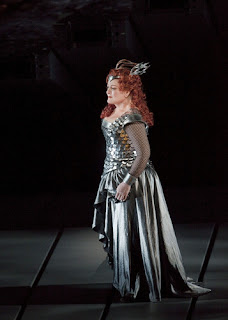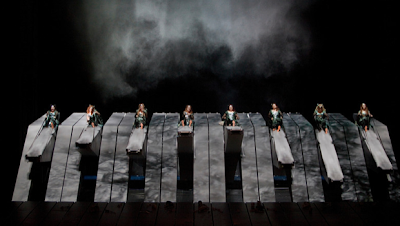We went to the Met’s season premiere of Die Walküre this weekend with great trepidation. After the epic set fails of The Machine at last Saturday’s season premiere of Das Rhinegold we were prepared for the worst. BUT The Machine executed it’s morphing set changes without a hitch….almost. Perhaps the multi million dollar reinforcements of the stage foundations and cutting the brand new Rigoletto set in half to preserve room for storage of The Machine are worth it?
Elizabeth – Before the show began, Peter Gelb walked onstage. Not a good sign. He announced that Simon O’Neill, the tenor playing Siegmund, woke up this morning with bad allergies. Gelb asked that the audience bear with O’Neill as he would like to perform. I can imagine losing that fee would have been a great disappointment.
 |
| Andrew Sritheran |
 The other principals were overall great. Martina Serafin, making her Met debut, had a gorgeous and powerful voice. She was wonderful as Sieglinde. Hans-Peter König’s Hunding was rich and deep. Mark Delavan had an amazing sing. His powerful voice was moving, particularly in Act III where he sadly punishes Brünnhilde. All the more impressive considering he was onstage for close to three hours. I enjoyed the character of Brünnhilde, the daring, brave, stubborn favorite daughter of Wotan, but Deborah Voigt seemed tentative and somehow not quite right for the role. Perhaps this tentativeness was due to the season premiere, but it just seemed a bit off. Stephanie Blythe returned as Fricka, and I thought she stole the show. What a gorgeous and powerful, nuanced voice. Wow.
The other principals were overall great. Martina Serafin, making her Met debut, had a gorgeous and powerful voice. She was wonderful as Sieglinde. Hans-Peter König’s Hunding was rich and deep. Mark Delavan had an amazing sing. His powerful voice was moving, particularly in Act III where he sadly punishes Brünnhilde. All the more impressive considering he was onstage for close to three hours. I enjoyed the character of Brünnhilde, the daring, brave, stubborn favorite daughter of Wotan, but Deborah Voigt seemed tentative and somehow not quite right for the role. Perhaps this tentativeness was due to the season premiere, but it just seemed a bit off. Stephanie Blythe returned as Fricka, and I thought she stole the show. What a gorgeous and powerful, nuanced voice. Wow.
More creative uses of The Machine were deployed this time. Its versatility is impressive. The Machine went from a forest of trees, to the inside of a house, to the roof of a house, to the mountain (complete with avalanches every time Wotan’s anger flared) whose peak Brünnhilde is eventually placed upon surrounded by Loge’s fire. At one point it is also the backdrop for the shadow story of Siegmund’s flight from his foes.
Shawn – After Das Rheingold’s epic set fails and freezes last week, the site of Peter Gelb slinking out onto the stage to address the audience did not bode well. He announced the tenor, Simon O’Neill, was having an extreme allergy attack but would go on. Okay, fair enough. I thought O’Neill sounded okay for the first 20 minutes, then however he stepped offstage mid scene and was replaced instantly by Andrew Sritheran, a full head taller and wearing a completely different costume. I found this confusing but not out of character with Wagner, as characters transform into dragons and serpents and mice, so why not a taller more shiningly clad tenor? My low Wagner IQ notwithstanding, I did figure out it was the same character untransformed and was able to recommit to the narrative. I still want to know how O’Neill signaled he wanted to sub out from the stage. It was pretty seamless if still visually jarring.
 The Machine still looks dangerous to me though. It is a bit distracting as I worried about the safety of the singers often. It looks very slippery. One slat of The Machine was often out of line with the others, which diminished the overall effect at certain points. Regardless it is a cutting edge theatrical device. Eventually I imagine there will be fully fluid set machines able to take whatever form is needed onstage. I found myself thinking of something like a gigantic pin art device, morphing into different three dimensional landscapes and set pieces. Something like that is still a ways off but no doubt some variant is coming and on the drawing board somewhere.
The Machine still looks dangerous to me though. It is a bit distracting as I worried about the safety of the singers often. It looks very slippery. One slat of The Machine was often out of line with the others, which diminished the overall effect at certain points. Regardless it is a cutting edge theatrical device. Eventually I imagine there will be fully fluid set machines able to take whatever form is needed onstage. I found myself thinking of something like a gigantic pin art device, morphing into different three dimensional landscapes and set pieces. Something like that is still a ways off but no doubt some variant is coming and on the drawing board somewhere.
– Elizabeth Frayer and Shawn E Milnes
Related Articles:
Twiddling Dials and Bulging Biceps: The Metropolitan Opera Renovations
Wagner and The Machine Infernal: Das Rheingold at the Metropolitan Opera
A Catholic School Girl’s Musings on Parsifal at the Metropolitan Opera
Ferruccio Furlanetto and the Heretic Burning Factory: Don Carlo at the Metropolitan Opera





Leave a Reply